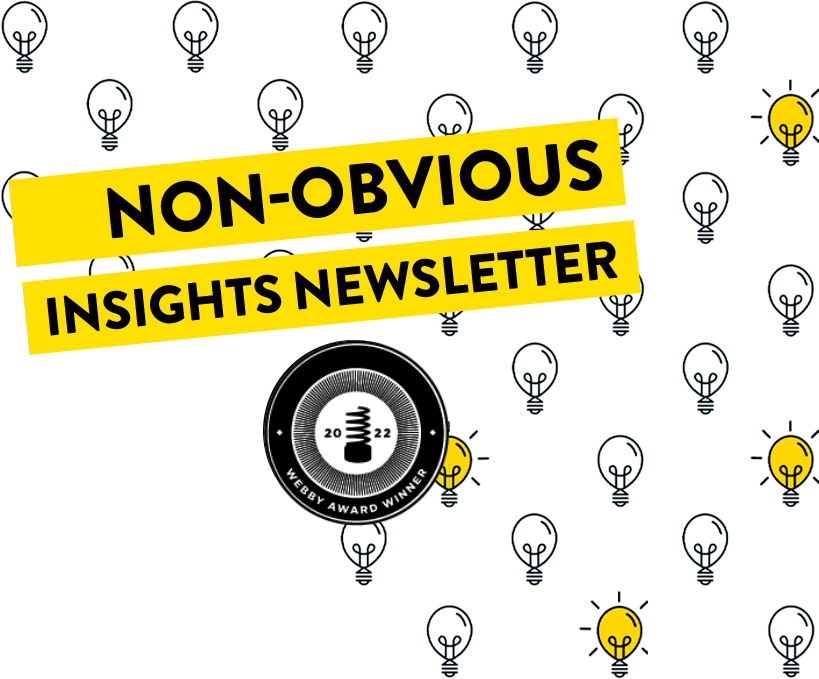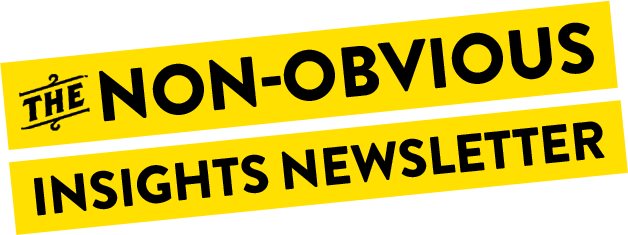Dear Fellow Trend Curator,
Earlier this week I shared some of my best tips for curating stories during a few virtual sessions I did from my home office before I hit the road again next week. It got me thinking about a quote from Isaac Asimov that I often share during my talks about how he once described himself as a “speed understander” rather than a speed reader. It struck me this week that it’s been some time since I shared a video I did a few years ago all about my process which I have described as the “haystack method.” In case you’re curious how I sort information and stories for my trend work AND for this newsletter, here’s the original video for your viewing pleasure!
For stories this week, we start with a fascinating exploration of the branding problem facing leather (and how it could be fixed). Other stories this week include a look at climate abandonment zones, a brilliant idea for delaying delivery on purpose, why it’s harder to hide secrets from AI and how iconic classic cars may get new lives as electric vehicles.
Enjoy the stories and stay curious!
The Problem with Leather
Have you ever seen a product promoted as being made with “vegan leather?” Assuming you have, do you actually know what that means? It turns out this is just one example of the growing problem faced by fashion brands using any form of leather in their products. There are new leathers made from plant materials like bamboo or cactus and fruit peels such as pineapple or apple. These options seem to be very eco-friendly, until you consider how much energy (and sometimes plastics) are still required to make them. Alternatively, traditional animal-derived leather is sometimes described as cruel or resource intensive but the truth about cow leather is that cow hides are generally a byproduct of the meat industry and therefore could be described as an example of upcycling. In other words, if we didn’t use cow hides to make leather, they would be discarded anyway.
So what can the identity crisis and widespread consumer confusion around leather, in all its formats, teach us about solving a tough industry-wide issue and offering clarity? The first is that education is key and there are more groups dedicated to trying to help people understand what the various terms and types of leather really mean. The second is branding. Right now, most forms of leather aren’t branded in a way that is easily understood and remembered. There is a reason people pay more for Gore-Tex or choose avocados from Mexico or choose to wear watches made in Switzerland. Until leathermakers of all sorts manage to create something similar, I suspect they will continue to struggle with this awareness and marketing problem.
Are We Heading Toward a World Filled with Climate Abandonment Zones?
People are stubborn. We see it in nearly every disaster movie where the flood or fire or aliens are headed straight for a town and there are people who still refuse to leave. They stare down the impending doom and assume everything will still work out. Sometimes, in the movies and in real life, it does. When it doesn’t, this commonly held faith in our shared ability to survive tragedy takes a hit.
A growing body of research is showing that more people over the next few years may finally be giving up hope and choosing to leave. If it does happen, this may create a number of “climate abandonment areas” where the young, middle class and those otherwise able to leave will choose to do so … leaving mainly the elderly and poor to shelter in place which in turn may lead to what demographers refer to as a population death spiral where those areas never recover.
It’s a doomsday scenario that some data suggests may have already started. Online real estate platform Zillow even announced they will start showing climate risk data alongside home sale listings. Whether you believe the warnings or think this exodus will be far more gradual (or perhaps never happen), this is a force that can reshape global geopolitics, centers of control and the current balance of power between states, countries, communities and generations.
Better Late Delivery: A Brilliant Idea More Retailers Should Offer to Delay Deliveries
Here’s a non-obvious question: what if you want your delivery to be delayed so it arrives later? There is a fundamental assumption at the heart of most online retail sales that you want your products or services as quickly as possible. Sometimes, it might be better to wait. Online UK-based flower retailer Bloom & Wild decided to offer a way for people to delay their gifts for new mums for 1 to 3 months. The insight behind it is that new parents generally get a LOT of gifts right when a baby is born while some of those gifts would be more meaningful and valuable if they came later.
Imagine a bouquet of flowers that shows up when your new baby just turns 3 months old, offering words of encouragement just at the time when new moms and dads are suffering most from sleep deprivation. Or onesies and clothes for a 6-month-old baby instead of lots and lots of newborn outfits that many babies will outgrow almost overnight. This isn’t just a great idea for baby gifts either.
A delivery delay would work for thoughtful graduation gifts, or a way to celebrate someone’s half birthday as a surprise and delight moment to make them feel good. The point is, sometimes the fastest possible delivery isn’t the optimal solution. Delayed delivery helps you time the moment for your gifting to make it more personal and memorable. Which is, of course, the point of giving a gift in the first place.
Hiding Our Secrets or Personal Struggles Is Going to Get Harder in the Age of AI
The way we search on Google is with keywords and phrases. Most of us probably would not want to think about how our search engine behavior might be tracked and what platforms like Google know about us as a result. Yet even though some searches may reveal embarrassing or intimate details, they are still generally presented in a keyword format. This isn’t the case for chatbots and conversational tools built with AI. They allow you to have an interaction that feels like a human conversation, but the disturbing side effect of this experience is that research shows we may inadvertently reveal too much about ourselves and our motivations to chatbots, including details we wouldn’t ordinarily share even with another human quite so readily.
The technology forces us to feel a level of comfort that encourages this type of sharing by making us feel like the conversation itself is a safe space. So we do share, failing to recognize that we are not only helping train an AI bot with the language of our lives but that also we may be feeding it data that will then be sold and reused by marketers to sell solutions to our problems.
Remaking Classic Cars into the EVs of the Future
When I was a kid and we would travel to India, all the taxis looked the same. The model that dominated back then, and for decades before and after was the Ambassador—alternately described as “virtually indestructible” and voted “the world’s best taxi.” Despite the fact that the factory making them operated from the 50s until closing in 2014, many of the cars on the road had, in fact, been built decades earlier.
Their longevity on the road was a curiosity that I only later discovered could be explained quite logically with a practice I was pretty sure never happened in America. When the engine and mechanics of an Ambassador taxi got too old to drive, they would just replace all of it and keep the shell of the car. In this process, many of those cars stayed in operation for decades.
I was reminded of those Ambassador cars this week as I read a story about how a company called Everrati is building a business out of electrifying iconic older cars. They too can take out the engine and inside of an older car and replace that interior with EV modifications. Right now, it seems mainly like a luxury service but if they can find some economies of scale, this service could be transformative. In case you were wondering, someone is indeed already working on electrifying those Ambassador taxis too.
The Non-Obvious Book of the Week
Stuff – Compulsive Hoarding and the Meaning of Things by Randy Frost and Gail Steketee
How much stuff is enough? Most of us would agree that compulsive hoarding crosses a line, but how common is it exactly and what can the behavior of “those people” living amongst thousands of stacked up magazines incapable of getting rid of any teach us about our own humanity? You’ll find the answers in this classic work of investigative journalism from Randy O. Frost and Gail Steketee that is approaching its 15th anniversary of original publication.
The work has a renewed relevance for today at a time when there is a widespread reevaluation of ownership itself combined with the increasingly popular idea that experiences (rather than material things) offer a more evolved path to joy. Yet the allure of having “stuff” continues to drive everything from luxury purchases to how we define our identities. Do the things we own define us the way they once did?
Inspired by more than a decade of research into the “hoarding epidemic” of the early 2000s, the insights in this book may simultaneously feel dated and timely, forecasting a future we haven’t yet arrived at. Our attachment to things is distinctly human, but perhaps this truth also offers us exactly the grounding we will all need in a rapidly digitizing world.
That’s what makes this book’s thoughtful exploration of stuff so compelling. It may start with the theater of hoarding, but it ends forcing us to take a deeper look at the true meaning of the things around us and what place they hold in our lives.
| About the Non-Obvious Book Selection of the Week: |
| Every week I will be featuring a new “non-obvious” book selection worth sharing. Titles featured here may be new or from the backlist, but the date of publication doesn’t really matter. My goal is to elevate great books that perhaps deserve a second look which you might have otherwise missed. |
Even More Non-Obvious Stories …
Every week I always curate more stories than I’m able to explore in detail. Instead of skipping those stories, I started to share them in this section so you can skim the headlines and click on any that spark your interest:
- The World’s First 3D-Printed Hotel Under Construction in Texas
- Over 33,000 Sound Effects Are Now Available from the BBC Archive
- How to Generate an AI Podcast Using Google’s NotebookLM
- Social Media Is Helping Bring Indigenous Languages Back from the Brink
- Paralyzed Man Unable to Walk After Maker of His Powered Exoskeleton Tells Him It’s Now Obsolete
How are these stories curated?
Every week I spend hours going through hundreds of stories in order to curate this email. Looking for a speaker to inspire your team to become non-obvious thinkers through a keynote or workshop?
Watch my new 2024 speaking reel on YouTube >>
This Non-Obvious Insights Newsletter is curated by Rohit Bhargava.
Copyright © 2024 Non-Obvious, All rights reserved.





